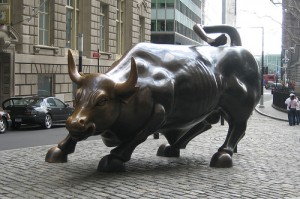 Over the weekend the high frequency trading (HFT) story exploded. HFT is when large traders place their own trading computers in exchanges. Doing this gives them a very sligh (microseconds) speed advantage over anyone who doesn’t have their computers co-located. Not only do they have a slight speed edge, in exchange for a fee they see orders slightly (a few microseconds) before other traders. They use this speed advantage to front run slower investors. In addition, they issue and then cancel orders to see what prices other traders are willing to pay. Using their speed advantage they can then, if they, for example, see you want to buy X stock at $5 or less, and it’s trading for $4.80, buy it before you and sell it to you at $5, capturing the profit in between.
Over the weekend the high frequency trading (HFT) story exploded. HFT is when large traders place their own trading computers in exchanges. Doing this gives them a very sligh (microseconds) speed advantage over anyone who doesn’t have their computers co-located. Not only do they have a slight speed edge, in exchange for a fee they see orders slightly (a few microseconds) before other traders. They use this speed advantage to front run slower investors. In addition, they issue and then cancel orders to see what prices other traders are willing to pay. Using their speed advantage they can then, if they, for example, see you want to buy X stock at $5 or less, and it’s trading for $4.80, buy it before you and sell it to you at $5, capturing the profit in between.
About 50% of market volume is now high frequence trading. Large firms front running smaller traders, engaging in strategies normal traders can’t engage in, to make sure that they make small profits on as much of the business going on as possible, all the while creating the illusion of real stock market activity when there is half the fundamental demand that there appears to be.
Fleecing sheep and manipulating the market seems to be the mild way to put it.
The solutions to this are simple enough. First getting information before other market participants do should be illegal. It is fundamentally anti-market. Ban that.
Second, add a micro fee or tax on every order, whether filled or not. Say one cent per. That will make much of this unprofitable, since it relies on micro-profits per transaction.
Third, capital gains tax at a very high rate (say 50%) any profits on securities held for less than a minute. Even most day traders don’t hold securities for less than a minute. Society wants secondary markets largely so that money can be raised on primary markets, this is not making raising money on primary markets more attractive.
There is no socially beneficial reason to allow high frequency trading, especially when it includes front-running. HFT defenders say it increases liquidity, but this mistakes churn, which is doing many small trades to get tiny profits per, with liquidity which is making sure those who actually want to own the stock can. Any minor liquidity benefits are minor compared to the cost, which is that HFT is capturing profits which would have gone to other market participants by having unfair advantages that smaller traders can’t match.
There’s a lot of suspicion that the US market is being manipulated in various ways. Ordinary investors are leary of getting back in. And scams like HFT are one of the reasons why: the market seems designed to work for large inside players and to fleece everyone else. The only reason you’d want in on that is if you know when to get off the train before the next train wreck. But that’s not a trading policy any sane society should allow.
